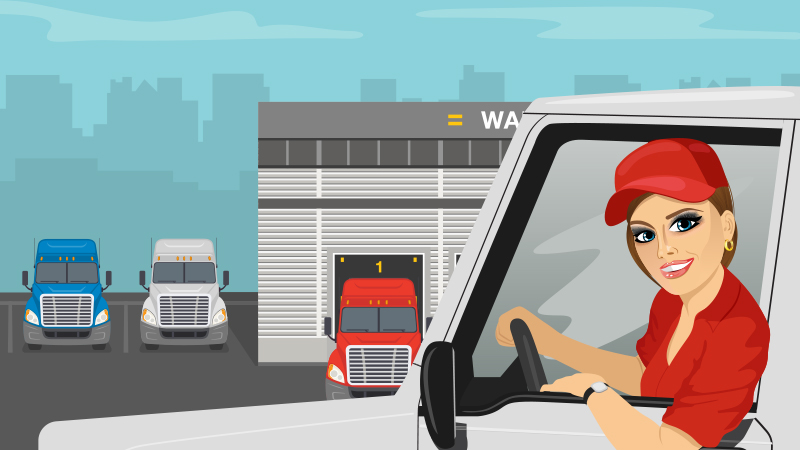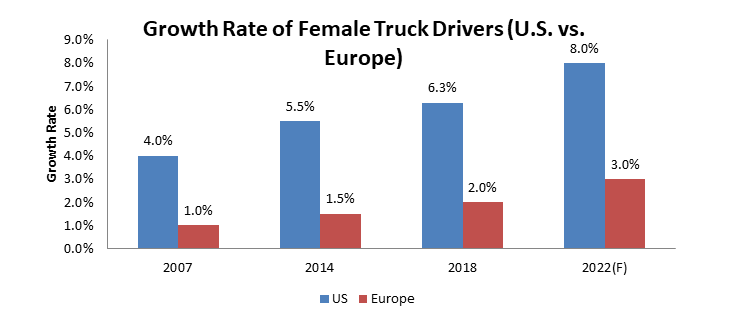
Impact of Female Commercial Truck Drivers on the Trucking Industry


The trucking industry across Europe and North America has seen the issue of driver shortage increase over the last decade. A “dirty man’s job” is how truck driving has been referred to, due to difficulties as well as complexities associated with truck driving. Truck driving has, however, seen a number of women getting involved in recent years across countries, despite it not being a preferred job for women. The industry has also started to encourage engaging of female truck drivers for long and short haul movements. This article talks about the implications associated with the involvement of females in truck driving, the challenges involved on the road for female truck drivers, their growth rate across multiple regions, and the ensuing benefits for the logistics as well as shipping companies in the engagement of female truck drivers.
Highlights
- U.S., which has more than 60,000 truck driver shortages as of 2018, has more than 6 percent female truck drivers involved in short and long haul movements in the country.
- Employment of women in truck driving is considered beneficial for trucking companies, as female truck drivers are considered safer truck drivers than male counterparts, and are also less likely to switch jobs.
- Increasing the number of truck drivers by engaging more women also reduces the percentage of wage increase every year, one of the major cost operating components passed on to the shippers.
- Engagement of women truck drivers increases the percentage of safe cargo delivery, as studies suggest that women truck drivers have lower chances of accidents when compared with male drivers, due to their adherence to speed limits, rules, and regulations.
Impact on Shippers and Benefits
Domestic transportation within countries across the globe primarily depends on road freight transport. FMCG, F&B, Retail, and Fashion are among the major industries that make use of trucks for domestic transportation as well as cross-border transportation. Wages contribute to more than one-third of the overall operating cost across countries in the EU, UK, and North America. Despite the economic conditions of countries, truck driver wages continue to increase every year between 2 and 8 percent depending on the country as well as prevailing driver shortage scenario. Engagement of women in driving trucks benefits the shippers on a large scale in two major ways:
Major Advantages for Shippers:
- Operational Cost
- Increased Trucking Capacity
- Engagement of Women Truck Drivers and Operational Cost Benefits for Shippers
IRU studies suggest that the EU faces the most number of truck driver shortages followed by the U.S. Statistics report the fact that every fifth truck driver position is vacant in Europe. Major reasons for the shortage include the poor reputation of the truck driving profession as well as the less number of women involved in driving trucks. Prior to the situation of truck driver shortage in EU, the overall wage percentage in operational cost increased by less than 1 percent every year. Since the scenario of driver shortage, however, wage percentage in operational cost has been increasing by more than 2 percent every year. The scenario is likely to worsen further with truck driver shortages forecast to increase from 21 to 40 percent within the next few years.
 |
|
 |
- Engagement of Women Truck Drivers and Increase in Trucking Capacity
Supply-demand is one of the major external factors that impact the overall freight prices in road freight, apart from the operating cost factors such as fuel, driver wages, maintenance cost, and others. The total number of trucks that are available in the market has not been a problem in many countries due to consistent new truck registrations in most countries across the globe. The actual issue has been the absence of sufficient truck drivers to operate the trucks. Engagement of a woman truck driver for every fifth (vacant) male driver position can increase the active capacity by 20 percent.
 |
|
 |
- Value Added Benefits of Women Truck Drivers in Terms of KPIs
Over speeding, safe delivery of cargo, and timing of delivery are major factors that impact a shipper’ business while transporting goods by any mode of transport. Engagement of women truck drivers not only provides cost and capacity advantages, but also seems to provide value added benefits in terms of the above mentioned factors.
-
Safe Delivery of Cargo: Women truck drivers are considered to be safer drivers when compared with male truck drivers. Trained female truck drivers adhere to road rules and drive trucks as instructed during training, which results in safe cargo delivery. This is highly likely to push shippers as well as trucking companies to engage more women for long haul movements.
-
Adherence to Timing: Women truck drivers stick to timelines as well as speed, ensuring that the cargoes get delivered on time. This increases the chances of delivery of cargo at the planned time, without compromising on rules and speed limits.
-
Fuel Efficient Drivers: Technology has come up with ways to ensure that truck drivers adhere to speed limits and save fuel. Women truck drivers tend to drive at a consistent speed as well as within speed limits, irrespective of presence or absence of technology for monitoring. This in turn saves fuel cost for the trucking companies.
Training Programs for Women
The domestic trucking industry across the globe has realized the importance of female truck drivers in the road freight industry, and has come up with training programs as well as additional incentives to attract more women to the job. Training methodologies have been introduced across multiple countries to increase the percentage of the total number of female truck drivers, a few of which are given below:
-
Train Your Spouse: USA initiated the “Train Your Spouse” program in 2016 in order to attract more women and reduce turnover among the existing workforce of women. It also added incentives to female truck drivers in order to ensure that they stay in the job. These actions resulted in increased revenue for carriers as well as better utilization of trucks.
-
Scholarship Funding: USA Truck teamed up with the University of Arkansas to sponsor 15 CDL school scholarships for female and male applicants in 2017, while Ryder Inc. donated $25,000 toward the scholarship fund created by the industry group, “Women in Trucking,” to encourage more female truck drivers.
“Train Your Spouse” and “Scholarship Funding” resulted in an increase of the female truck driver population by more than 10 percent, ultimately leading to the current share of 6-7 percent among the total truck driving population.
- Subsidies for Women: Lodz Association of International Carriers and Forwarders in Poland came up with the idea wherein candidates get a lorry license, training, including eco-driving, and even a guarantee of employment—all for free for women, resulting in a saving of ~4000 euros. This has resulted in more than 25 women opting for truck driving.
Female Truck Drivers – For Short Haul or Long Haul
Women truck drivers mainly drive reefer trucks as well as dry vans that support major industries such as FMCG, F&B, retail, fashion, and household goods, and are not preferred for operating articulated trucks as well as tankers. While short haul trucking provides female truck drivers with the cushion of safety and allows them to get back home every day, long haul driving has been the preferred trend by the majority of female truck drivers in the U.S. Also, long haul trucking is where the shortage is on the rise. Love for driving and higher wages are the major two reasons for female truck drivers preferring long haul movements, even while confronting sexism and hygiene issues. America estimates to have ~217,000 long haul women truck drivers, with a majority of them attracted to the high wages. The industry’s average wages in 2017 was ~$53,000, and had crossed ~$55,000 in 2018 due to the increase in truck driver shortage. As highlighted by the numbers, long haul movements are preferred by female truck drivers, despite the challenges they pose.
Engagement of Women – Long Term or Short Term Solution
The percentage of women truck drivers stood at ~1, 4, and 2 percent in Europe, U.S., and Canada respectively before 2010. However, with the increase in the shortage of truck drivers, introduction of training programs for women, scholarships, and incentives, the percentage of female truck drivers has increased to 2, 6, and 3 percent in Europe, U.S., and Canada respectively. With women capable of both long haul and short haul movements, and the industry not being able to find any immediate solutions for the driver shortage crisis, the engagement of female truck drivers is looked upon as a long term solution.
The expected growth rate of female truck drivers in the U.S. is higher than in Europe, thanks to the incentives and interest among women in the U.S. The growth trend highlights the fact that the engagement of women in truck driving is not just a long term solution, but will also see the numbers grow in the future.
Conclusion
The trucking industry is dominated by men across all countries and is unlikely to see any major changes in the short term. The industry is currently going through sweeping changes in terms of technology where automated truck driving is looked upon as one of the major solutions for the future, which can combat the ever-increasing truck driver shortage crisis. However, implementation of such technology is not likely to be imminent.Female truck drivers are looked upon by a lot of companies as a major solution to combat the driver shortage crisis, as highlighted by the increase in the overall percentage of female truck drivers across countries. The industry can also benefit in terms of KPIs such as timing of delivery, fuel efficiency, and safe delivery of cargo by engaging more female truck drivers. However, it remains to be seen whether the industry can attract the desired number of female truck drivers who can disrupt the male dominant trucking industry in the long run.
References
- https://www.ecodrive.co.uk/more-women-encouraged-to-become-truck-drivers/
- https://trans.info/en/every-fifth-truck-driver-position-in-europe-is-vacant-soon-there-could-be-twice-as-many-131212
- https://www.truckinginfo.com/321290/omnitracs-women-truck-drivers-safer-than-men
- https://www.usatoday.com/story/news/nation/2019/03/09/women-truck-drivers-shortage-opportunities-pay-big-rigs/2845083002/
- https://cdllife.com/2019/ice-road-truckers-looking-for-women-truckers-to-star-in-new-season/
- http://wastemanagementreview.com.au/volvo-backs-new-program-women-drivers/
Related Insights:
View All
Get more stories like this
Subscirbe for more news,updates and insights from Beroe








D